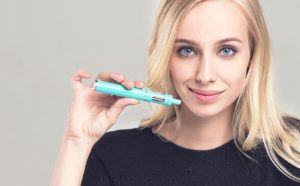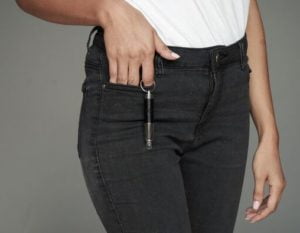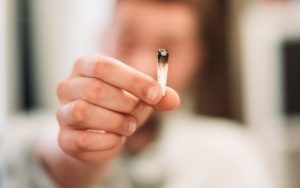Cleaning a Vaporizer
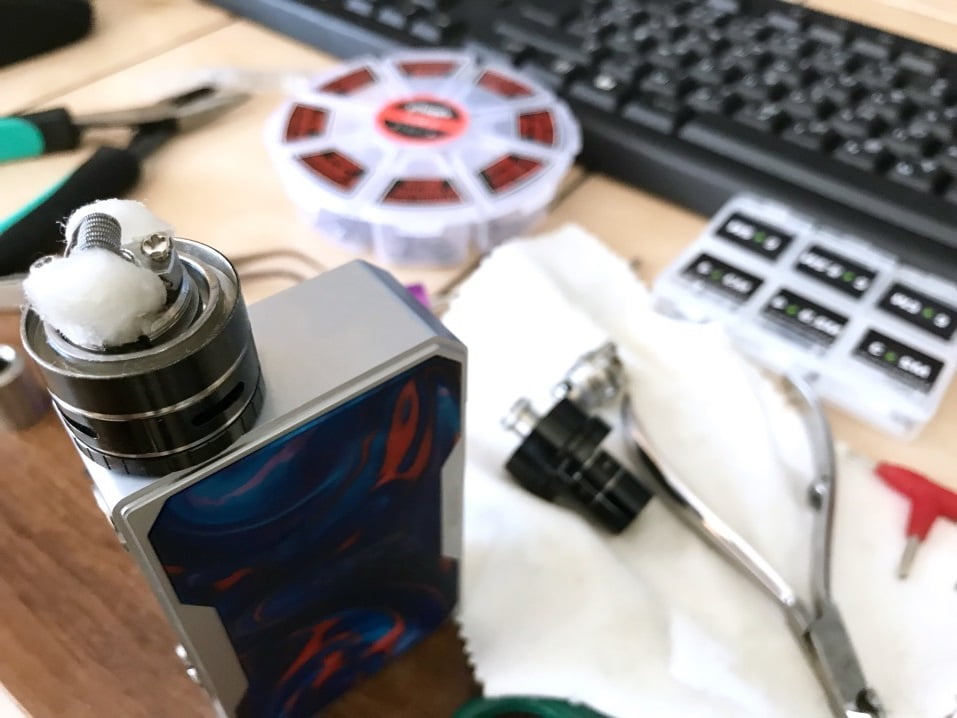
Dry Herb Atomizer
Everyone knows that vaporizers need to be cleaned regularly. But how do you clean your vaporizer properly? We want to give you an overview of what needs to be considered when cleaning.
The cleaning is best done with isopropyl alcohol, as it is a very strong solvent. How do I clean a vaporizer with and without isopropyl alcohol? Which elements can be soaked or wiped off and which should not come into contact with alcohol at all? Figure it out!
Cleaning the vaporizer: 7 easy steps
- Disassemble the vaporizer into individual parts for cleaning
- Place soiled parts in glass or Ziplock bags.
- Top up with isopropyl alcohol and shake gently.
- For about 30 min. let absorb.
- A toothbrush can help with stubborn incrustations.
- Then rinse the parts with clean water and let them dry.
- A hair dryer can speed up the drying process.
Tip: The alcohol can be collected and used several times.
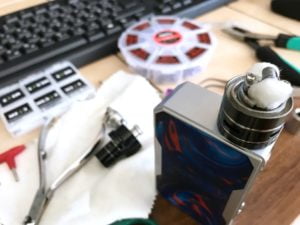
What to do with new vaporizers and spare parts?
A vaporizer that has just been purchased should be cleaned before its first use, similar to a new coffee machine. We therefore recommend rinsing all individual parts with water, especially metal and plastic parts. You can fully charge the vaporizer BEFORE you use it for the first time and then let it “evaporate” at a high temperature without a mouthpiece. The process can be repeated if necessary. We recommend taking a short break between each process.
Tip: You can take some AVB (Already Vaped Bud) or ginger and fill the chamber with it. Then you heat up the device and then carefully blow into the steam path from the other side. This means that residues from production are lost that could otherwise cause a possibly bad taste. This is highly recommended for new devices. Unfortunately, this technique doesn’t work with all portable vaporizers.
Why is regular cleaning so important?
Why is it so important that every vaporizer is cleaned regularly if it is to work well? One of the reasons is the fact that the warm vapor condenses from contact with the cooler elements of the vaporizer, creating a sticky, resinous buildup. As airways become clogged over time, the performance of any vaporizer will degrade over time. At the beginning, the steam quality drops, then the air flow is gradually blocked. A lack of cleanliness shortens the service life and functionality of a vaporizer, regardless of its processing quality.
We shouldn’t ignore the health aspect either, as only a clean vaporizer can produce clean vapor. Cleaning therefore directly affects the quality of the steam! Residues cause the vaporizer to lose power and, in the worst case, even damage the heating element.
A word about the guarantee conditions of vaporizers:
Only those who handle all parts of their vaporizer carefully can ensure that all defects and malfunctions that may occur are covered by the guarantee conditions.
How do I properly clean an herbal vaporizer?
The residue can be removed relatively easily with isopropyl alcohol. Caution is advised here, however, as the solvent is very strong and not all materials should come into contact with it. It is best to wear gloves while cleaning.
If you consider the following tips, cleaning will be quick and effective. Your vaporizer will look almost like new afterwards.
Cleaning the vaporizer after each use without alcohol:
Most vaporizers on the market come with a small cleaning brush. If a brush wasn’t included, you’ll need something small enough to fit in the herb chamber. The brush should have hard bristles rather than soft ones. In this way residues can easily be brushed off. We recommend brushing out the herb chamber and sieves after each use. Wipes soaked in alcohol can also quickly help remove minor gum deposits.
IMPORTANT: Never allow brushes or plastic pipe cleaners to come into contact with hot parts. Let the device cool down sufficiently to avoid this.
Cleaning the mouthpiece and cooling chamber:
Here it is particularly important to check and clean the sieve. It can either be brushed off, or the holes can be cleaned of residues with a needle. Do not use water and do not rinse the vaporizer under running water! This can damage the electrical components.
Pipe cleaners or cotton swabs can be useful instead of a brush for cleaning after each session. Sieves are good for cleaning with alcohol. The cooling chambers can usually be removed and broken down into several parts. That makes cleaning easier.
Which vaporizer parts can be cleaned with isopropyl alcohol?
The easiest way to clean the vaporizer parts is to soak each component in isopropyl alcohol. You can always do this when you feel that the vaporizer needs to be cleaned properly (1-2 times a week should be enough). The following rule of thumb applies: the longer the parts are soaked, the easier it is to clean them by hand. You can soak all the glass and steel elements – they can stay in the alcohol overnight. In the morning it is usually sufficient to rinse the parts under clear water and let them dry properly.
Some plastic elements, such as the Crafty + and Mighty cooling chambers, can also be soaked in isopropyl alcohol (make sure to remove the seals beforehand!). However, caution should be exercised with plastic parts. The term “plastic” is not clearly defined and includes different types of materials. Some of them (for example, high density polyethylene or polypropylenes) can be cleaned with alcohol without any problems, but others may discolor or dissolve if soaked in alcohol. Since the end customer usually does not know exactly which type of plastic is ultimately used in the production of the vaporizer, we recommend another method here.
Instead of soaking the plastic elements, they can also be wiped off with a cotton ball soaked in alcohol or a Q-tip. This way you can be sure that the alcohol cannot damage the plastic parts of your vaporizer. We recommend Limpuro bio-cleaner for cleaning sealing and inhalation tubes made of glass and silicone. This cleaner is gentle but strong enough to remove most of the dirt.
How to clean a vaporizer:
What things are needed:
- Kitchen roll: for drying individual parts after cleaning
- Isopropyl alcohol: Dissolves contamination from sticky resins and herbs very well
- A resealable jar: To store the alcohol for later use
- A zip-lock bag: To clean the vaporizer parts inside
Alcohol cleaning wipes: These cleaning wipes soaked in alcohol are ideal for quick cleaning in between, especially for quickly wiping a heating chamber or a mouthpiece. They’re also great for finishing touches, especially on glass surfaces like the Firefly 2+ vapor path.
Pipe cleaners: are ideal because they fit so well into the nooks and crannies of some parts (e.g. the curved aroma mouthpiece of the Solo 2 or the aroma tube of the Air 2).
Cotton swabs: are ideal for cleaning the herb chamber
Old children’s toothbrush: For particularly stubborn areas
All parts that are placed in alcohol can best be put in a zip-lock bag or Tupperware, add a little alcohol, close the bag securely and then shake vigorously (be careful with glass parts, not too vigorously). Shaking it will help remove the debris. In the case of stubborn soiling, the parts can be inserted overnight. Then rinse with water and allow to dry.
You can keep the alcohol in a glass after cleaning and use it several times. If the solution is dark brown then it should be renewed. The airway can be cleaned with a pipe cleaner soaked in alcohol (Pax 3, Davinci MIQRO).
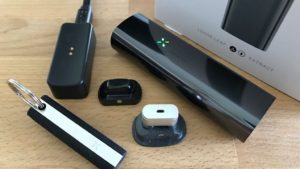
We soak the cotton swabs in alcohol and wipe the chambers with them, for example. An old children’s toothbrush can be very helpful for particularly stubborn dirt. You can use it to clean cooling elements like the Mighty particularly well. Metal screens can be wiped clean or simply soaked in alcohol.
Materials that should not be cleaned with isopropyl alcohol:
Wood should never be treated with isopropyl alcohol. If wooden elements come into contact with this type of alcohol, they can be permanently damaged or deformed. So never clean wooden elements with alcohol. Instead, you can just use a cotton ball and warm water. It can be useful to treat the wood regularly with wood wax to maintain the quality.
Light plastic and sealing rings should also not be placed in alcohol. But it doesn’t hurt to wipe these parts briefly with alcohol and rinse them with clear water.
How do I clean an oil or wax vaporizer?
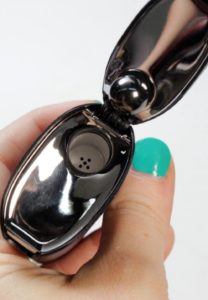
Most oil vaporizers use a heating coil in the herb chamber to vaporize concentrates. Since this part is particularly sensitive, it should not be handled with pointed and sharp objects. This will not damage the coil.
Basically, cleaning is recommended when the vaporizer is still warm. This makes it much easier to remove residues. However, caution is required here.
Use a cotton swab or the included cleaning tool (if available) to remove small particles from the chamber. Alcohol can be used to wipe the outside of the chamber or cartridge. Most mouthpieces can simply be placed in alcohol as described above. Rinse with clean water and allow to dry well.
6 easy steps to cleaning an oil vaporizer:
This is how you can clean your oil vaporizer very easily and with little effort:
Separate the chamber and mouthpiece.
Use a Q-tip and alcohol to remove the residue from the chamber. You have to be careful here if your vaporizer has a heating coil so that you do not damage it.
Repeat the process until the chamber is free of debris.
Alternatively, the chamber can be warmed upside down on a heating plate. So, the oil can simply run out of the chamber. It’s best to put aluminum foil or baking paper between the chamber and the heating plate.Put the device back together.
Now the cleaned vaporizer can work 100% for you again.
TIP: If you use a vaporizer with a transparent tank, you should ensure that the cartridge or the entire device is protected from direct sunlight. This is the only way to keep the material fresh and maintain its potency.
Cleaning and care save money:
If cleaning your vaporizer still doesn’t seem important to you, just think about how much money you could save. If you can double the life of eg sieves, mouthpieces etc. with these simple tips by cleaning them at least once before they are thrown away, you can save 50%. Over the course of two years, the life of a high-end vaporizer, that really adds up.
Using your vaporizer after cleaning:
Regardless of which elements were cleaned with alcohol and which with water, the vaporizer should be “steamed out” after each cleaning. To do this, turn on the device with an empty chamber, set the temperature to a low value (at least 100 ° C) and let the vaporizer run for a few minutes. This way you can get rid of any leftover isopropyl alcohol or water (can be repeated if necessary). It is much better to vaporize them than to inhale them during the first session after cleaning.
While isopropyl alcohol is the most effective and cheapest solution when it comes to cleaning vaporizers, you should always consider what type of material it can be used on. Of course, you can always ask us questions about the cleaning process and the materials of your vaporizer.
After a brand change, we also recommend thorough cleaning of all components to guarantee the pure taste.
